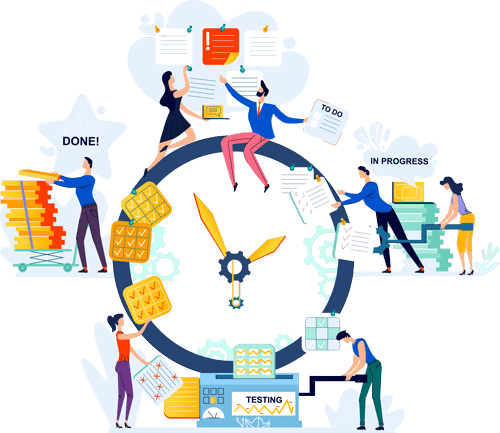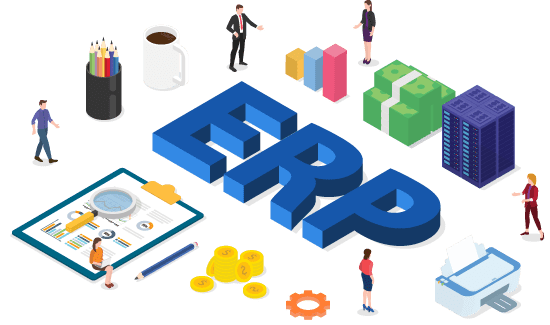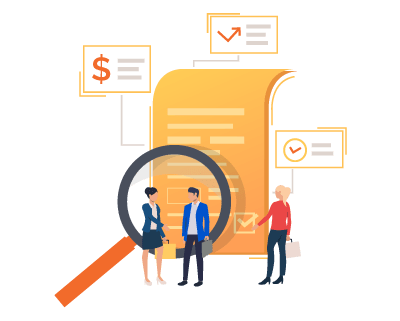While you might not be hearing the term enterprise software development for the first time, you may not be fully aware of its potential either. Well, you are not alone, as it can sometimes get overwhelming to stay on top of the ever-emerging cutting-edge trends and terminologies coming right up one after another. Practically, in this era of connected customers, how well an enterprise builds and handles its connections with the customers and employees has a huge impact over the bottomline of your business and so, the faster you harness the power of enterprise software, the closer your business will be towards achieving its core goal.
Without further ado, let’s take a deep-dive to understand the nitty-gritties of the enterprise software development process!
What Is Enterprise Software Development?
As we know the word ‘enterprise’ literally means an economic organizational unit, a business venture to be precise, the idea of enterprise software development can easily be conceived as building a software which caters to the needs of an enterprise. However, putting a full stop at that makes it look straight out of a textbook, and such rudimentary definition can hardly do any justice to the question you have – leaving you with another bunch of unanswered questions like ‘which enterprise needs does it talk about?’ , ‘how does the software help the enterprise?’, ‘how can the same software help different enterprises?’ etc.
Here’s a more informed piece to help you get all the answers you are looking for:
In an enterprise there are a number of common departments like customer service, sales, internal and external communication, production unit etc. dealing with activities like productivity measurements, logging day-to-day operational data, sharing business data among different levels and much much more.
Now, looking at the software side, enterprise software development plays a key role to simplify critical business processes, automating a majority of tasks and solving problems inherent to that specific enterprise.
In essence, Martin Fowler, the renowned developer and consultant, rightly classifies the primary activities of enterprise application software broadly into two sections in his book Patterns of Enterprise Application Architecture:
To display, manipulate, and store large amounts of complex data.
To support and/or automate business processes relying on this data.
Characteristics and Properties of the Enterprise Software Development
Enterprise software development should ideally revolve around the processes of particular context (may be a particular business process, a business unit or even an entire company) for which it is being built, rather than following a generic set of principles. Since these softwares are designed prioritising a specific business goal, every piece of its architecture serves part of the purpose of the project. So, while thinking of developing enterprise software, it is important to be familiar with each of its characteristics, so that you can prepare every specification accordingly and get the best possible software solution for your enterprise.

Performance
Most obviously, how an enterprise software performs is of prime concern, because it has parts of it very closely associated with the critical business processes, and if any one of the parts underperform or go defunct, the entire system gets affected. Unfortunately, such mishap can not even be prevented or handled by quality performance of other parts of the software in action. That’s exactly why ensuring strict quality control and periodic testing during enterprise software development is a mandate.
Security
Security is imperative when it comes to any business activity – be it server, code, system, cyber security or even the devices making up the network. Because the slightest loss of security or breach of confidential business information can potentially wreck a business. Thus, preventing any sort of loss in business information, hacks or unstable networks is a must. On that note, the enterprise software development process needs to enforce stern security features throughout the mutually agreed scope of the project, as well as ensure the software is security compliant when it is handed over to the enterprise.


Scalability
A software which lacks scalability has fairly high chances to lag behind in the competitive market, killing the true potential that your business has. So, the basic enterprise software development architecture should always consider scope of sudden growth and should ensure specific parts of the software can be scaled-up aligned with the growth to avoid any interruption in performance.
Cost
Who doesn’t know the value of money and time for a business, but almost every enterprise looking for a software has this question in mind, “How much money enterprise software development actually costs?”
The answer lies in the understanding of the development process of an enterprise software itself. That means, starting from a thorough planning to maintenance phase, through analysing each monetary factor linked with every resource invested from start to end of the project, every underlying features and functionalities that need to be incorporated, make the cost go up. So to be upfront, if you are looking for a holistic approach in your enterprise software development, you can never have that for peanuts!


ROI
Cost control gets even more rigorous in case of enterprise software development, as there’s a high expectation in terms of return on investment (commonly termed as ROI) as well as the time of return, linked with the software.
This factor, ROI, is what the businesses bet on while spending a few bucks extra for a quality enterprise software development, and thus verifying the software’s productivity, impact, and efficiency before finalizing a project, holds immense value to give you a somewhat clear picture of what ROI you should expect.
However, compare your return on investment after using the software for a year or two and let the results act as a feedback loop for your next enterprise software development project.
Customization
Every business has their own unique workflow and that is exactly what the ideal enterprise software development process should implement for your business. That means, forcing your business processes into a software built on a generic workflow (basically, what an off-the-shelf software will make you do!) will do more harm to your business than making it better. For example, requiring you to give up on your unique approach, losing competitive advantage in the name of adjustments to just begin with. Alternatively, investing in the right custom enterprise software development effort, will save you a great deal of time along with a considerable amount of money by automating a majority of the repetitive tasks and minimizing the inevitable manual errors.


Robustness
The list of factors characterizing enterprise software development doesn’t end above, as besides cost, security and performance, robustness is of equal significance. Since we all know exceptions are not exceptional in business scenarios, an enterprise has to face certain deviations that need to be addressed at that instant to ensure the workflow doesn’t crash. Thus, an enterprise software needs to be robust enough to handle any deviations without interruption.
Concurrent Access & Interconnectivity
As the name suggests, enterprise software is to be used by the employees related to the business at any given instant, rather than one individual at a time. So, during enterprise software development we need to make sure, the software should enable concurrent access of business data and easy connectivity among different networks as the software needs to run seamlessly on multiple devices like desktops, mobile phones etc. and also be able to connect with one another as and when required.


Storage
Storage is a crucial aspect of enterprise software development and so, it requires precise details to be considered. Dealing with petabytes of information is not the only concern here, as without proper storage it can be of zero use. Whether it be conducting audits, measuring productivity, in-depth analysis over areas for improvement, or by putting the best tech-foot forward using business intelligence, determining a proper structured storage is a must. The cloud is becoming increasingly popular as a storage option in recent times, but, with newer technologies coming up, it’s best to consult a tech expert or a team with proven expertise to help you choose the best storage complementing your business infrastructure.
Integration
For an enterprise software, integration with existing tools, devices and third-party softwares is very important, as otherwise it gets difficult to pass on information from one to another, running from one device to next. If we neglect enterprise application integration during the development phase, internal processes of the business are exposed to increased risks. However, if well integrated with the long-used softwares, tools and similar components, working becomes easier and productivity of the software goes up, too.

Difference between Enterprise Software Development and Standard Software Development
| Topic | Enterprise Software Development | Standard Software Development |
|---|---|---|
| Purpose | Enterprise software development takes into account the interest of an enterprise i.e. a medium to big sized organization. | Standard software development focuses on a particular person’s needs or a group of people sharing similar requirements |
| Environment | Enterprise software development is usually done in a closed and limited work environment | Standard software is generally developed in a demographically located open market environment. |
| Target Users | In case of enterprise software development, the target user base is more homogenized, as they use the tool in a standardized manner aligned with pre-structured definite business processes. | Standard software development targets a heterogeneous base of users meaning user experience can vary based on difference in thoughts, individual way of interaction with the software etc. |
| Efficiency | Enterprise software development tends to result in a more efficient software with considerably high productivity as it’s designed to meet specific needs of a business. | A standard software if developed for mass consumption, usually requires individual users to adjust their processes according to the generic flow implemented in the software, thus efficiency mileage may vary. |
| Data Storage | Quality storage is a vital part of an enterprise software development process as enormous business data is what all the activities revolve around. | For a standard software, storing any significant data may or may not be required depending on the specific goal it aims to accomplish |
A Technical Partner Might Be A Great Choice At This Point!
If your company size is small to medium, chances are there that you have an IT department with a few in-house technology specialists, but maybe you lack a technical co-founder. But when you think of developing a software for your business that automates processes, eases internal operations or complements your existing software, perhaps the best bet would be guidance from a technical co-founder or an experienced consultant.
The expert suggestions will lead you to revitalize your systems and drive even your most critical internal processes smoother. If you are not able to have a technical co-founder onboard immediately but don’t want to leave your software requirements waiting either, feel free to contact us for help!
Examples of Enterprise Software Development
Rapid evolution of enterprise software development has made lives of even small to medium-sized businesses easier, leveraging cutting-edge technologies to streamline business processes, gain significant insights and, finally, enhance revenue and accelerate growth.
Have a look at some of the top enterprise software applications that you shouldn’t deprive your enterprise of!

Customer Relationship Management Software
The truth is, unless you have superhuman organizational skills and machine-like memory, sticking to regular follow-ups simply with manual efforts is bound to get tedious. As a result, from “striking opportunities for closing a deal”, to “marketing brand new products to your existing clientele”, will remain unattended.
A CRM bridges the gap between your customer relationship management activities and your already tight schedule, by:
- Giving you a crisp overview of your business relationship with individual clients
- Putting all the customers’ contact information channel-wise in one place
- Storing details of your last interaction with customers – be it in person, via social media, through a phone call, email etc.
- Automating outgoing and incoming customer support call management, so that a precious customer does not fall off your radar due to lack of communication.
The best CRM software includes but is not limited to features such as, workflow automation, centralized document repositories, role-specific user access, supporting multi-currency, communication tracking and integration, lead capture etc.
Project Management Software
The tag of a project manager sure looks lucrative to the outside world, but only the business insiders know the real day-to-day struggle for manually monitoring the ongoing projects, allocating resources priority-wise, scheduling and checking progress after regular intervals.
Project Management Software is the technical helping hand for you in this scenario, as this takes care of an array of project management activities like-
- Collaboration with in-house team & remote employees as well as your global software outsourcing partners
- Keeps the milestones and target clearly defined and listed to make sure none of your employees lose sight of the deliverables
- Sends reminders regarding deadlines of the ongoing and the upcoming tasks of multiple projects as assigned
- Tracks progress of the running projects
- Gives an overview of all active projects and fetches necessary details of your desired project.
- Gets you all the inputs you require from your fellow clients on-time, so you don’t need to worry about missing a deadline
If used the right way, CRM makes for a great option to visualize distributed workflows, pull up productivity, keep up an uniform pace – and leave no task forgotten.


Marketing Automation Software
Your product or service doesn’t really have much value unless you market it right. In today’s competitive market, everyone claims theirs to be the best but how well they market it, is the key factor to decide how interested the customer is going to be. A marketing automation software comes handy to ease you marketing activities like:
- Sending product / service information to the customers over varied channels (social media, phone, email, digital ads etc.)
- Sending promotional offers
- Segment your list of existing and potential customers and design & schedule targeted marketing campaigns
- Notify you regarding customer’s interest
A marketing automation software can put the best of technical enhancements to use, to carry out your long-practised marketing process with higher accuracy and efficiency. So, your team can concentrate on developing great content and setting ambitious strategies for business growth.
Enterprise Resource Planning Software
With discrete departments of a business (like Finance, HR, IT, manufacturing, procurement etc.) working separately yet requiring to access the same data, there is always dire need for a centralized system to avoid data silos. Enterprise Resource Planning software meets that need by:
- Integrating with other significant tools like CRM, financial information, assets, inventories, POS data, databases etc.
- Digitally integrates all the departments into a core system forming a single up-to-date record of the core information
- Provides factual insights to identify the bottlenecks and helps you plan for future more efficiently
Deploying an ERP in your business turns your business activities more cohesive and adds to the transparency. So, you get increased efficiency in lesser cost and processes streamline with better productivity with a custom developed ERP.


Scheduling & Booking Software
Scheduling of appointments and bookings can get tough at times amidst the other day-to-day routine tasks, but not with a dedicated software, as a scheduling and booking software:
- Sends out appointment reminders in advanced time
- Synchronizes time for both employees and customers through calendar integration
- Processes payment via integrated payment methods and generates receipt for the customer and keeps all the transactions logged
The software does not just solve the issues of manual execution but also provides a better customer experience, by enabling them to book services from anywhere and at any point of time over the internet, along with instant booking confirmation.
Purchase Order Management Software
Orders from biggies in the business often pose a threat to your inventory but, only until you have a well structured purchase order management software in place! The software can:
- Send you alerts when inventory stock goes low
- Automatically create and send either complete or partial purchase orders
- Tracks suppliers and compare their individual pricing to take smarter purchase decisions
- Efficient bulk purchase management
- Monitor placed purchase orders to follow-up with the respective suppliers
- Store supplier details, past purchase orders and generate periodic reports for the same
While there is no dearth of purchase order management softwares in the market, not each one (read, most) of them can manage purchase requisitions and vendor-interactions as efficiently. So, make sure you choose the right software keeping an eye on all convenient features in detail!


Analytics Software
As almost every other business is going paperless with digitization, most obviously the process of preparing analytics has upgraded too. Now, with the help of an analytics software, you can skip the task of going through stacks of business files as the software can serve you with accurate insights by:
- Drilling down data to greater levels of detail as well as roll up to broader perspectives when needed
- Integrate with your existing IT environment ( think of ERP, CRM, databases, even spreadsheets!) to fetch data spontaneously
- Versatile report generation i.e. simple and smart dashboards to make the data better absorbable to the customers, and in-depth detailed analytics for you to explore opportunities and discover insights into latest marketing trends or customer preferences.
An user friendly analytics software can help your business with more collaborations and add value to your enterprise with interactive analytics.
Enterprise Software Development With BinaryFolks – But Why?
YGWYS is our mojo and our approach towards serving you is bound to leave you (and your business!) happy. Here’s what makes us the Nemo amidst a school of fishes!

94% repeat clients !! No – not Witchcrafting!!
We are not a multi-billion dollar company, so no, we don’t have the money-power to appear in Bloomberg TV or CNBC and scream at the top of our voice about “how good we are”. But luckily, our clients have got us covered right from the time BinaryFolks started its journey. Starting from our early days with cutting edge Startup Clients from Silicon Valley, USA to our latest batch of esteemed Corporate Giants from Fortune 500 list. They all have highly spoken about us to their peers and that resulted in very reputed clients trusting us with their high value and business changing projects.
All of these above definitely give us an assurance that we are moving in the right direction.
The result? 94% of the clients who tried us in the first place, made us their permanent choice and never looked back!

We don’t haste a YES to a Baked Alaska only to hand you over an Ice Lolly at the end!
As a software development company, the easiest way to keep the cash register ringing, is to say a YES to every project that comes on their way – regardless, how feasible the execution seems to the development team. For instance, a client comes up with the intention to build ‘something like Amazon’ within a couple of months, under a budget of < $20K. Guess what a majority of development companies would say? A YES, of course! Clearly, because the term ‘something like’ is highly ambiguous – it can be a molehill, it can be a mountain and anything in between! That is where our approach is slightly different, we first breakup your high level requirement to very low level feature set, so both parties can understand the gravity of work and a clear scope is established. Then we put it under different lenses, like

We don’t ASSUME your dream – We ASK!
Unscientific assumptions taken to reduce time(read cost!) are dangerous, especially in case of cross border business relationships, I’ll tell you why!
Think of the rain – how it brings pretty rainbows and the lush back in the greens, but also those muddy puddles. Like every other good thing in life, cross border relationships also come with a handful of cons, too, and miscommunication is one such. But an experienced one knows how to jump over hurdles – be it a puddle or, the difference in consumer expectation, demographic demands or work-cultural difference between different countries. So, we do the due diligence to put enough time to read, research and then ask very pointed and relevant questions (those which our clients’ haven’t regretted answering yet ! ) about your dream project so that if you had a slightly disturbed sleep still there is no gap in your dreams, it’s pretty crystal clear in front of your eyes(as well as ours), before you even spend your first dollar.

Little slow to commit, but once committed, it’s written on stone!
We don’t take commitment lightly and thus, don’t come up with instant commitment just to bag the project. We only commit, once we have a detailed understanding of the project that you have in your mind and we have planned the project and mapped our team’s experience & expertise with it and also done the due diligence that if the allotted time and money is sufficient enough to ensure a quality outcome without cutting corners.
Historically in our journey, apart from one client from China(no offence here !), we never had a disagreement with any of our clients about the planned outcome of a project and in reality what we delivered!

Technology NO BAR!
We don’t choose technology based on our comfort zone!
So, instead of thrusting our technical choice on your project, we cover an extra mile. We do a thorough research on your project and figure out the major components for your project. Then we determine the platform suitable for those chosen components. Even if the components require multiple technologies for superior performance, we still do that even though that puts considerable extra load on our developers ! Thus, our developers are always on their toes, adapting to new technologies fast, only to hand you over a project which is rock-solid & scalable – reaping the best of benefits out of the advanced and stable technologies of the time.
Conclusion
Enterprise software uses digitization to speed up the business processes and execute them more efficiently.
For best of both productivity and efficiency, custom enterprise software development is the best bet, as it is tailor-made for your own unique enterprise requirements.
Custom enterprise software development projects hands you over precise control in terms of features and functionalities that differentiates it from the process of standard software development.
Being developed and planned in the long term perspective, enterprise software generally has a longer useful lifespan.
A technical co-founder or an expert software development team guidance is great to start the development process planning with. As with a specialist’s guidelines you won’t just get tips and tactics driven by their experience and knowledge, but will also get innovative ideas, meaning the much required competitive edge keeping your business ahead of the rest.
Featured Projects
FAQs
These enterprise applications are built to focus specifically on the requirements of enterprises and the problems they face during their day-to-day operations. These applications also provide a common platform to coordinate and cooperate with all the units of the enterprise like accounting, inventories, human resources, finances etc.
All these factors when considered together will help you decide the overall cost of the enterprise software development.
Read more: How to Estimate Custom Software Development Costs?
Enterprise software solutions will help your business to improve customer satisfaction, improve employee experience, enhance productivity and better ROI.
Read more: 10 Essential Enterprise Software Solutions that Every Business Need
The enterprise application comes with a lot of expectations- from smooth functioning to adaptability to changing technologies. Having a clear understanding of the challenges can help an enterprise app development company to build a successful and adaptive application.
Technology is growing immensely and so is the competition. Staying up to date and leveraging the right tools and technologies can help overcome these challenges.
Read more: Enterprise Application Development Challenges and How to Overcome them?
Enterprise application, on the other hand, is specifically built for the enterprises or business to manage and optimize their operations allowing them to save time and money along with increasing efficiency and productivity.






